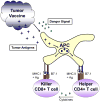Use of tumour-responsive T cells as cancer treatment
- PMID: 19231634
- PMCID: PMC2975274
- DOI: 10.1016/S0140-6736(09)60404-9
Use of tumour-responsive T cells as cancer treatment
Abstract
The stimulation of a tumour-specific T-cell response has several theoretical advantages over other forms of cancer treatment. First, T cells can home in to antigen-expressing tumour deposits no matter where they are located in the body-even in deep tissue beds. Additionally, T cells can continue to proliferate in response to immunogenic proteins expressed in cancer until all the tumour cells are eradicated. Finally, immunological memory can be generated, allowing for eradication of antigen-bearing tumours if they reoccur. We will highlight two direct methods of stimulating tumour-specific T-cell immunity: active immunisation with cancer vaccines and infusion of competent T cells via adoptive T-cell treatment. Preclinical and clinical studies have shown that modulation of the tumour microenvironment to support the immune response is as important as stimulation of the most appropriate effector T cells. The future of T-cell immunity stimulation to treat cancer will need combination approaches focused on both the tumour and the T cell.
Conflict of interest statement
MLD is an inventor on patents held by the University of Washington pertaining to T-cell therapies. EMJ has been a consultant for Amplimmune, where she provides advice on new agent development (pre-clinical advice to date); has been a consultant for Bristol-Myers Squibb in the past year; has licensed intellectual property to Anza Corp and has the potential to receive royalties in the future; and although she does not receive any financial support or has the potential for royalties, John Hopkins has the potential to receive royalties from Cell Geneys on the GVAX vaccine in the future. HB declares that she has no conflict of interest.
Figures


Similar articles
-
Broadly expressed tumour-associated proteins as targets for cytotoxic T lymphocyte-based cancer immunotherapy.Expert Opin Biol Ther. 2005 Sep;5(9):1183-92. doi: 10.1517/14712598.5.9.1183. Expert Opin Biol Ther. 2005. PMID: 16120049 Review.
-
Immunotherapy II: Antigens, receptors and costimulation.Cancer Metastasis Rev. 1996 Sep;15(3):329-49. doi: 10.1007/BF00046346. Cancer Metastasis Rev. 1996. PMID: 9034595 Review.
-
Specific immunotherapy of cancer in elderly patients.Drugs Aging. 2001;18(9):639-64. doi: 10.2165/00002512-200118090-00002. Drugs Aging. 2001. PMID: 11599633 Review.
-
Advances in personalized neoantigen vaccines for cancer immunotherapy.Biosci Trends. 2020 Nov 4;14(5):349-353. doi: 10.5582/bst.2020.03267. Epub 2020 Sep 10. Biosci Trends. 2020. PMID: 32908077 Review.
-
Challenges and future perspectives of T cell immunotherapy in cancer.Immunol Lett. 2015 Aug;166(2):117-33. doi: 10.1016/j.imlet.2015.05.018. Epub 2015 Jun 19. Immunol Lett. 2015. PMID: 26096822 Free PMC article. Review.
Cited by
-
Immunomodulatory effects of cyclophosphamide and implementations for vaccine design.Semin Immunopathol. 2011 Jul;33(4):369-83. doi: 10.1007/s00281-011-0245-0. Epub 2011 May 25. Semin Immunopathol. 2011. PMID: 21611872 Review.
-
Vaccine-Mediated Inhibition of the Transporter Associated with Antigen Processing Is Insufficient To Induce Major Histocompatibility Complex E-Restricted CD8+ T Cells in Nonhuman Primates.J Virol. 2019 Sep 12;93(19):e00592-19. doi: 10.1128/JVI.00592-19. Print 2019 Oct 1. J Virol. 2019. PMID: 31315990 Free PMC article.
-
A DNA telomerase vaccine for canine cancer immunotherapy.Oncotarget. 2019 May 21;10(36):3361-3372. doi: 10.18632/oncotarget.26927. eCollection 2019 May 21. Oncotarget. 2019. PMID: 31164958 Free PMC article.
-
Cancer vaccination drives Nanog-dependent evolution of tumor cells toward an immune-resistant and stem-like phenotype.Cancer Res. 2012 Apr 1;72(7):1717-27. doi: 10.1158/0008-5472.CAN-11-3758. Epub 2012 Feb 14. Cancer Res. 2012. PMID: 22337995 Free PMC article.
-
Identifying the Most Effective Hydatid Cyst Fluid Fraction for Anticancer Vaccination of 4T1 Breast Tumor-Bearing Mice.Int J Prev Med. 2019 Aug 12;10:143. doi: 10.4103/ijpvm.IJPVM_508_18. eCollection 2019. Int J Prev Med. 2019. PMID: 31516684 Free PMC article.
References
-
- Ellyard JI, Simson L, Parish CR. Th2-mediated anti-tumour immunity: friend or foe? Tissue Antigens. 2007;70:1–11. - PubMed
-
- Dong C. Diversification of T-helper-cell lineages: finding the family root of IL-17-producing cells. Nat Rev Immunol. 2006;6:329–33. - PubMed
-
- Zou W. Regulatory T cells, tumour immunity and immunotherapy. Nat Rev Immunol. 2006;6:295–307. - PubMed
-
- Pages F, Berger A, Camus M, et al. Effector memory T cells, early metastasis, and survival in colorectal cancer. N Engl J Med. 2005;353:2654–66. - PubMed
Publication types
MeSH terms
Substances
Grants and funding
- P50 CA088843/CA/NCI NIH HHS/United States
- U19CA72108/CA/NCI NIH HHS/United States
- U19 CA072108-06/CA/NCI NIH HHS/United States
- P50 CA062924/CA/NCI NIH HHS/United States
- CA85374/CA/NCI NIH HHS/United States
- P50CA88843/CA/NCI NIH HHS/United States
- R01 CA101190-01/CA/NCI NIH HHS/United States
- CA101190/CA/NCI NIH HHS/United States
- R01 CA085374/CA/NCI NIH HHS/United States
- R01 CA085374-01/CA/NCI NIH HHS/United States
- UL1 TR002319/TR/NCATS NIH HHS/United States
- R01 CA101190/CA/NCI NIH HHS/United States
- P50 CA062924-140014/CA/NCI NIH HHS/United States
- CA62924/CA/NCI NIH HHS/United States
- P50 CA088843-010006/CA/NCI NIH HHS/United States
- U19 CA072108/CA/NCI NIH HHS/United States
- UL1 TR000423/TR/NCATS NIH HHS/United States
LinkOut - more resources
Full Text Sources
Other Literature Sources

